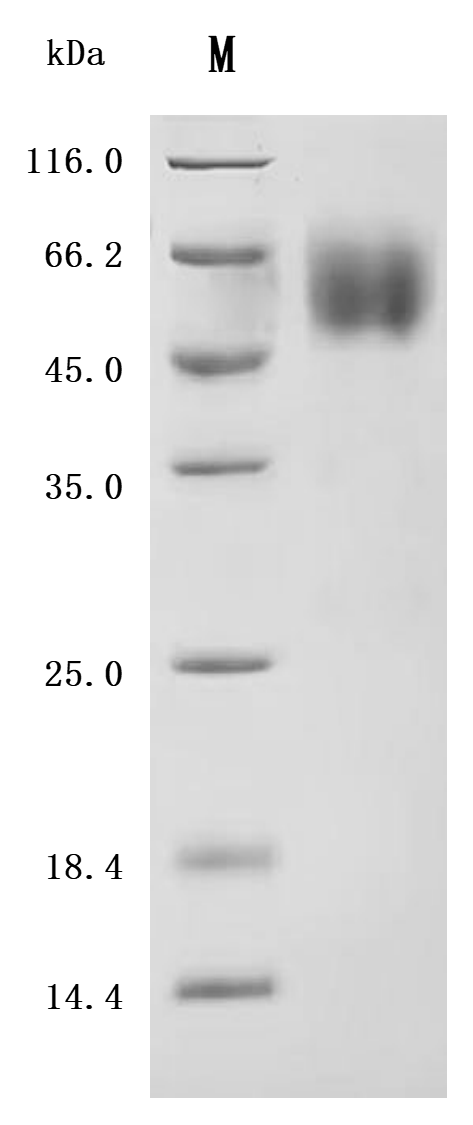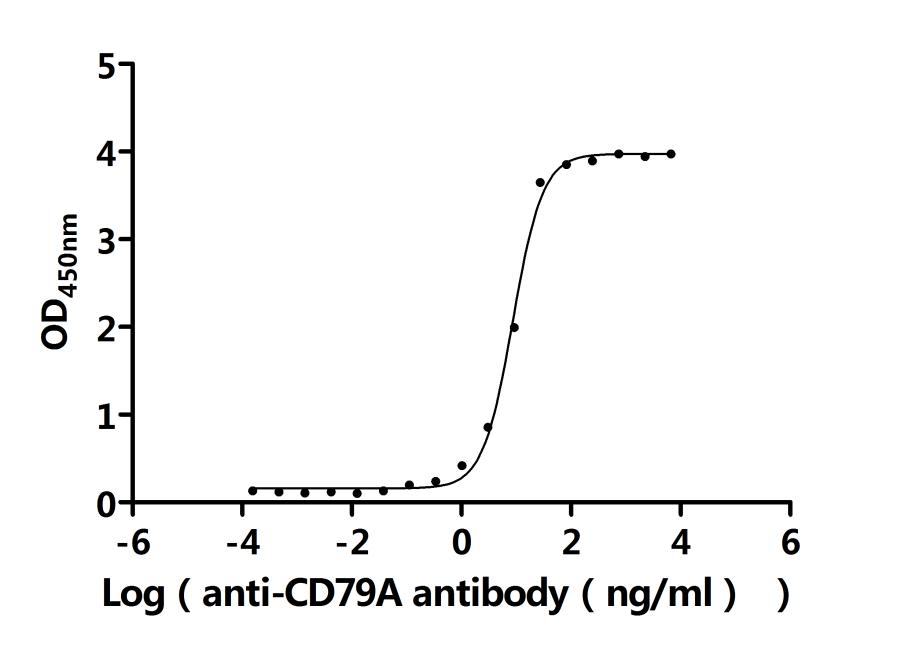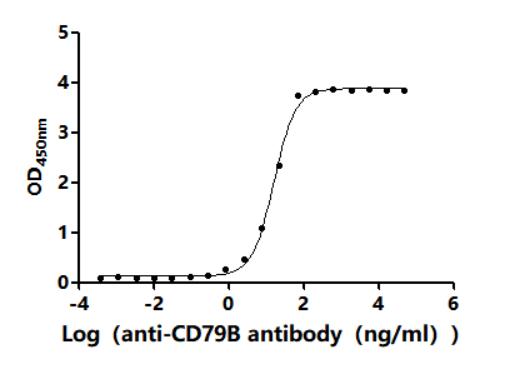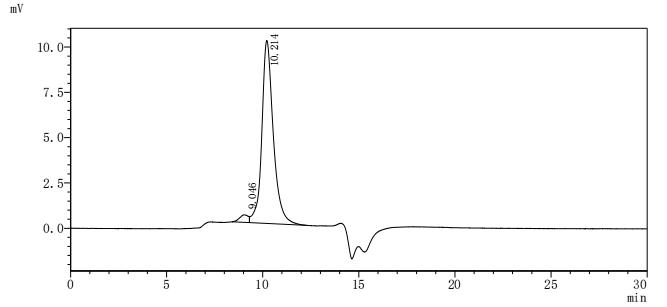The recombinant human CD79A&CD79B protein is a co-expressed, biologically active product designed to mimic the native B-cell receptor (BCR) complex component. It is produced in a mammalian expression system to preserve structural fidelity and post-translational modifications. This construct includes amino acids 33–143 of CD79A and 29–159 of CD79B and is tagged with an mFc-Flag at the C-terminus of human CD79A and a 10xHis-mFc at the C-terminus of human CD79B, enabling efficient purification and detection. It demonstrates greater than 95% purity by both SDS-PAGE and SEC-HPLC, with endotoxin levels strictly controlled below 1.0 EU/μg, verified by the LAL method. Functional assays confirm its binding capacity with the anti-CD79A recombinant antibody (CSB-RA004957MA1HU) and the anti-CD79B recombinant antibody (CSB-RA004958MA2HU), with an EC50 of 8.012–9.339 ng/mL and 14.85–17.47 ng/mL, respectively. These results support its use in immunological studies, antibody screening, and B-cell signaling pathway research.
CD79A and CD79B are integral components of the BCR complex, crucial for developing and activating B lymphocytes. CD79A, also known as Igα, and CD79B, known as Igβ, play distinct but complementary roles in modulating B-cell receptor signaling and ensuring effective immune responses.
CD79A and CD79B function as the signaling subunits of the BCR, assisting in the transduction of signals that initiate B-cell activation following antigen recognition. Specifically, both proteins contain immunoreceptor tyrosine-based activation motifs (ITAMs) essential for BCR signaling. When the BCR engages with antigens, CD79A and CD79B undergo phosphorylation, which leads to the recruitment of signaling proteins that activate various downstream pathways, including those mediated by MAP kinases and transcription factors [1][2]. This signaling network stimulates B-cell proliferation, differentiation, and antibody production.
Research indicates that CD79A and CD79B are important for the transition of progenitor B cells to pre-B cells and for the development of mature B cells in response to BCR engagement [3][4]. They contribute to tonic signaling that maintains B cell survival and functionality independently of external signals [1][5]. Furthermore, studies have demonstrated that the interplay between these two molecules is significant for the B-cell response. For example, CD79B is involved in both positive and negative signaling, depending on the nature of the ligand-bound state of the receptor [6][4].
The expression of CD79A and CD79B is tightly regulated throughout B-cell development and differentiation. For instance, CD79B is often downregulated in terminally differentiated plasma cells, reflecting a key transition in the B-cell lifecycle [7]. This downregulation corresponds with the loss of surface immunoglobulin expression, linking CD79B with B-cell receptor activity during antigen-specific responses [7]. Abnormal expression of CD79A and CD79B is also implicated in various B-cell malignancies, including non-Hodgkin lymphoma and chronic lymphocytic leukemia, where altered signaling pathways can lead to uncontrolled proliferation of B cells [8].
In summary, CD79A and CD79B serve critical roles in B-cell development, survival, and activation through their involvement in BCR signaling. Their regulated expression and functional activities are crucial for maintaining normal B-lymphocyte functions and developing certain hematologic malignancies, establishing them as important focal points in B-cell biology and therapeutic research.
References:
[1] X. Huang, K. Takata, et al. Downregulation of the b‐cell receptor signaling component cd79b in plasma cell myeloma: a possible post transcriptional regulation. Pathology International, vol. 61, no. 3, p. 122-129, 2011. https://doi.org/10.1111/j.1440-1827.2010.02634.x
[2] T. Tanaka, K. Ichimura, et al. Frequent downregulation or loss of cd79a expression in plasma cell myelomas: potential clue for diagnosis. Pathology International, vol. 59, no. 11, p. 804-808, 2009. https://doi.org/10.1111/j.1440-1827.2009.02448.x
[3] D. Luger, Y. Yang, et al. Expression of the b-cell receptor component cd79a on immature myeloid cells contributes to their tumor promoting effects. Plos One, vol. 8, no. 10, p. e76115, 2013. https://doi.org/10.1371/journal.pone.0076115
[4] I. Hardy, N. Anceriz, et al. Anti-cd79 antibody induces b cell anergy that protects against autoimmunity. The Journal of Immunology, vol. 192, no. 4, p. 1641-1650, 2014. https://doi.org/10.4049/jimmunol.1302672
[5] H. Brühl, J. Cihak, et al. B‐cell inhibition by cross‐linking cd79b is superior to b‐cell depletion with anti‐cd20 antibodies in treating murine collagen‐induced arthritis. European Journal of Immunology, vol. 45, no. 3, p. 705-715, 2014. https://doi.org/10.1002/eji.201444971
[6] C. Kooten, L. Galibert, B. Seon, P. Garrone, Y. Liu, & J. Banchereau. Cross-linking of antigen receptor via ig-β (b29, cd79b) can induce both positive and negative signals in cd40-activated human b cells. Clinical & Experimental Immunology, vol. 110, no. 3, p. 509-515, 1997. https://doi.org/10.1046/j.1365-2249.1997.4201436.x
[7] E. Yoo, N. Cooke, & S. Liebhaber. Identification of a secondary promoter within the human b cell receptor component gene hcd79b. Journal of Biological Chemistry, vol. 288, no. 25, p. 18353-18365, 2013. https://doi.org/10.1074/jbc.m113.461988
[8] D. Lü, J. Jin, et al. Semi-mechanistic multiple-analyte pharmacokinetic model for an antibody-drug-conjugate in cynomolgus monkeys. Pharmaceutical Research, vol. 32, no. 6, p. 1907-1919, 2014. https://doi.org/10.1007/s11095-014-1585-y







